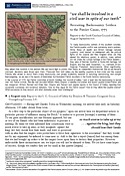REBELLION: 1775-1776
4. Loyalists IV: Backcountry
- Recruiting backcountry settlers to the Patriot cause, reports to the South Carolina Council of Safety, 1775, selections PDF

W. H. Drayton, Report to the S.C. Council of Safety, 1775
In the southern colonies, Loyalism flourished among the wealthy elite of English heritage, but most backcountry settlers were slow to become involved in the controversy over imperial taxation. Most were yeoman farmers who were not rich and not English—they were of German, Scottish, or Scots-Irish heritage—and they were non-Anglican "dissenter" Protestants. Most significantly, they valued their isolation in the western hills and would fight to protect their liberty as independent frontiersmen. Yet as war became imminent, decisions were forced upon them. Pressured from both sides—by the wealthy Loyalists in their midst and the coastal Patriots who arrived to recruit them—backcountry men proved stubbornly resistant to recruiting, sermonizing, and fear mongering, as we see in the reports of determined but frustrated Patriot recruiters in the South Carolina backcountry.
Recruiting backcountry settlers to the Patriot cause, reports to the South Carolina Council of Safety, 1775, selections. In the summer of 1775, as militia organization was escalating throughout the colonies, Patriot leaders in South Carolina sent a team into the backcountry to recruit men into militias—and to overwhelm the influence of landowning Loyalists. The five men included William Henry Drayton, a wealthy rice planter and recent Loyalist-turned-Patriot, and two clergyman, William Tennent and Oliver Hart. Drayton and Tennent sent regular reports to the leaders (in the South Carolina Council of Safety), recounting their occasional successes and numerous setbacks. How did they present the Patriot cause to the settlers? When facts didn't persuade, what did they resort to? How did they refute the Loyalists' positions and try to block their influence? How did each side portray the other in the battle for hearts and minds? Who "won"? (8 pp.)
Discussion Questions
- From these reports, describe the political atmosphere in the southern backcountry in 1775.
- What were the major causes of backcountry settlers' resistance to the Patriot cause? to aligning with either side?
- How did Drayton and Tennent present the Patriot position and refute the Loyalist stance?
- When reasoning failed, what justifications, implications, anxieties, and threats did they employ? to what effect?
- What obstacles to recruitment proved most challenging?
- How did Drayton and Tennent address these obstacles, and how did they explain them to the Council of Safety?
- Generate a list of the most likely questions and challenges from backcountry men attending the recruitment meetings.
- With this in mind, what recommendations would you have made to Drayton and Tennent for their recruitment campaign?
- Why did the South Carolina Council of Safety include two clergymen in the group of three recruiters?
- How did powerful Loyalists work to minimize Patriot recruitment in the backcountry?
- How did each side portray the other in the battle for hearts and minds? Who "won"?
- From the evidence in these reports, how committed were the backcountry men who joined the Patriot militias in 1775?
- What other political pressures affected the Patriot-Loyalist competition in the backcountry?
- William Henry Drayton had been a longtime Loyalist but in 1774 adopted the Patriot cause and explained his reversal in a published letter. Read selections from his letter and the rebuttal by an anonymous "Back Settler" (CRISIS #7, compilation, pp. 9-10). How did Drayton's conversion influence his tactics as a Patriot recruiter?
- Compare the Drayton-Tennent reports with the accounts of the Patriot-Loyalist divide by two British visitors, Nicholas Cresswell in Virginia and Janet Schaw in North Carolina (see REBELLION #3). What differences and similarities do you note? What might explain them?
- Using other readings and images in this primary source collection, compare the Loyalist-Patriot divide in the southern colonies and the northern/middle colonies.
Framing Questions
- What rebellions and "civil wars" occurred within the colonies as war approached in the mid 1770s?
- How did colonists express and debate their differing opinions?
- How did they deal with political opponents?
- What caused the moderate voice to fade from the political arena?
- What led Americans to support or oppose the ultimate goal of independence?
Printing
Drayton-Tennent reports to the S.C. Council on Safety8 pp.
Supplemental Sites
"The Back-Country Commission of Tennent, Drayton, and Hart," by Loulie Latimer Owens (University of South Carolina Libraries)
Travel Journal and Album of Collected Papers of William Tennent III, 1740-1777 (University of South Carolina Libraries)
The South Carolina Loyalists, including Thomas Fletchall (J. D. Lewis)
Ninety-Six National Historic Site, South Carolina (National Park Service)
Thomas Brown, Georgia Loyalist, later leader of South Carolina backcountry Loyalists, overview (New Georgia Encyclopedia)
David Fanning, North Carolina Loyalist (N.C. Historic Sites)
"Was the American Revolution Inevitable?," not-to-miss teachable essay by Prof. Francis D. Cogliano, University of Edinburgh (BBC)
Teaching the Revolution, valuable overview essay by Prof. Carol Berkin, Baruch College (CUNY)
General Online Resources
Images courtesy of the Library of Congress, Geography & Map Division:
– C. Bowles, North America, and the West Indies, London, 1774 (?) (detail); G3300 1763 .B63 Vault.
– B. Romans, A General Map of the Southern British Colonies in America, London, 1776 (detail); G3870 1776 .R6 Vault: Low 585.
Banner image: Original Declaration of Independence, parchment, 1776 (detail); on exhibit in the Rotunda of the National Archives, Washington, DC. Courtesy of the U.S. National Archives and Records Administration.
*PDF file - You will need software on your computer that allows you to read and print Portable Document Format (PDF) files, such as Adobe Acrobat Reader. If you do not have this software, you may download it FREE from Adobe's Web site.



